
The Tennessee River is the largest tributary of the Ohio River. It is approximately 652 miles (1,049 km) long and is located in the southeastern United States in the Tennessee Valley. The river was once popularly known as the Cherokee River, among other names, as the Cherokee people had their homelands along its banks, especially in what are now East Tennessee and northern Alabama. In addition, its tributary the Little Tennessee River, flows into it from Western North Carolina and northeastern Georgia, where it also was bordered by numerous Cherokee towns. Its current name is derived from the Cherokee town, Tanasi, which was located on the Tennessee side of the Appalachian Mountains.
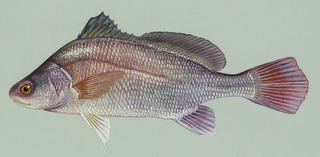
The freshwater drum, Aplodinotus grunniens, is a fish endemic to North and Central America. It is the only species in the genus Aplodinotus, and is a member of the family Sciaenidae. It is the only North American member of the group that inhabits freshwater for its entire life. Its generic name, Aplodinotus, comes from Greek meaning "single back", and the specific epithet, grunniens, comes from a Latin word meaning "grunting". It is given to it because of the grunting noise that mature males make. This noise comes from a special set of muscles within the body cavity that vibrate against the swim bladder. The purpose of the grunting is unknown, but due to it being present in only mature males and during the spawning season, it is assumed to be linked to spawning.
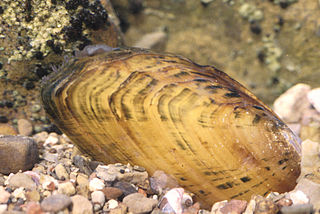
The cracking pearlymussel is an endangered species of freshwater mussel, an aquatic bivalve mollusk in the family Unionidae.
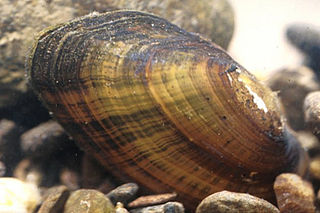
The Appalachian elktoe is a species of freshwater mussel in the family Unionidae, the river mussels. It is native to the United States, where it is known only from North Carolina and Tennessee.
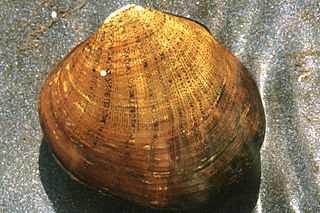
Dromus dromas, the dromedary pearlymussel or dromedary naiad, is a rare species of freshwater mussel in the family Unionidae. This aquatic bivalve mollusk is native to the Cumberland and Tennessee River systems in the United States, where it has experienced a large population decline. It is a federally listed endangered species of the United States.
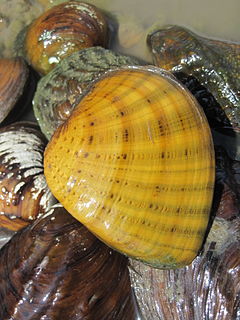
Ellipsaria lineolata is a species of freshwater mussel, an aquatic bivalve mollusk in the family Unionidae, the river mussels. This is the sole species in the monotypic genus Ellipsaria . This species is native to the drainage systems of the Mississippi River, the Mobile River, the Tennessee River, and the Cumberland River in the United States. It exists in the midwestern United States, and has also been observed in the east coast and as far south as the Gulf of Mexico. The common name of Ellipsaria lineolata is the Butterfly Mussel.

Epioblasma biemarginata, the angled riffleshell, was a species of freshwater mussel, an aquatic bivalve mollusk in the family Unionidae, the river mussels. It is now extinct.

The oyster mussel is a rare species of freshwater mussel in the family Unionidae. This aquatic bivalve mollusk is native to the Cumberland and Tennessee River systems of Kentucky, Tennessee, Alabama, and Virginia in the United States. It has been extirpated from the states of Georgia and North Carolina. It is a federally listed endangered species of the United States.
Epioblasma personata, the round combshell or fine-rayed pearly mussel, is an extinct species of freshwater mussel in the family Unionidae. It was endemic to the drainages of the Tennessee River and Ohio River in the United States.

Fusconaia cuneolus, the fine-rayed pigtoe pearly mussel or fine-rayed pigtoe, is a species of bivalve in the family Unionidae. It is native to Tennessee, Alabama, and Virginia in the United States, in each of which its population has declined severely. It is a federally listed endangered species of the United States.
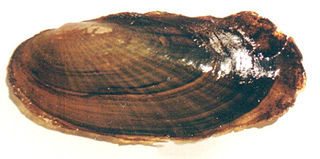
Leptodea leptodon, the scaleshell mussel or scale shell, is a species of freshwater mussel in the family Unionidae, the river mussels. This aquatic bivalve mollusk has disappeared from much of its historical range. It is endemic to the United States, where it is now present in four or fewer states; it is only found with any regularity in Missouri. It is a federally listed endangered species of the United States.
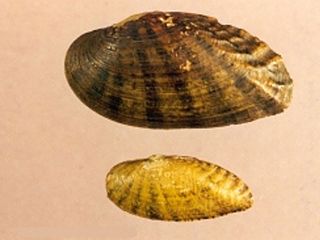
Medionidus acutissimus, the Alabama moccasinshell, is a species of freshwater mussel in the family Unionidae, the river mussels. It is native to Alabama, Mississippi, Georgia, Tennessee, and possibly Florida. It is a federally listed threatened species of the United States.
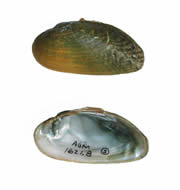
Medionidus parvulus, the Coosa moccasinshell, is a rare species of freshwater mussel in the family Unionidae, the river mussels. This aquatic bivalve mollusk is native to Georgia and Tennessee in the United States, and has been extirpated from the state of Alabama. It is a federally listed endangered species of the United States.

Obovaria retusa is a rare species of freshwater mussel in the family Unionidae, the river mussels. Its common names include golf stick pearly mussel and ring pink. It is native to parts of the eastern and southeastern United States, but it remains in very little of its original range. There may be no viable populations left. This is a federally listed endangered species of the United States.

Pegias is a monotypic genus of freshwater mussels in the family Unionidae. This genus contains the single species Pegias fabula, known commonly as the littlewing pearlymussel.
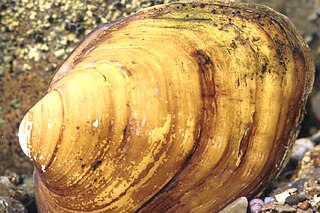
Plethobasus is a genus of freshwater mussels, aquatic bivalve mollusks in the family Unionidae, the river mussels.

Plethobasus cooperianus, the orange-footed pimpleback mussel or orangefoot pimpleback, is a rare species of freshwater mussel in the family Unionidae, the river mussels. This aquatic bivalve mollusk is native to the Tennessee, Cumberland, and lower Ohio Rivers in the United States, where its distribution has declined over 70%.

Plethobasus cyphyus, the sheepnose mussel, is a species of freshwater mussel, an aquatic bivalve mollusk in the family Unionidae, the river mussels.
The Georgia pigtoe is a rare species of freshwater mussel in the family Unionidae. It is native to Alabama, Georgia, and Tennessee in the United States, where it has been extirpated from most of its historical range. It was declared extinct by the IUCN, but a few living individuals were discovered persisting in the Conasauga River in Georgia and Tennessee. It was federally listed as an endangered species in 2010.

Theliderma intermedia, the Cumberland monkeyface pearly mussel or Cumberland monkeyface, is a species of freshwater mussel in the family Unionidae, the river mussels. This aquatic bivalve mollusk is native to Tennessee and Virginia in the United States. Historically widespread in the upper Tennessee River system, it populations have been reduced by habitat destruction and pollution. It now only occurs in two tributaries: the Duck and Powell Rivers. It is a federally listed endangered species.


















